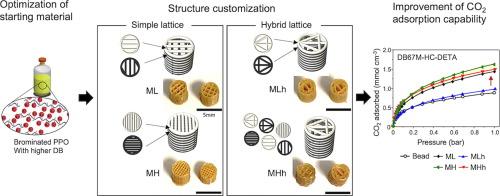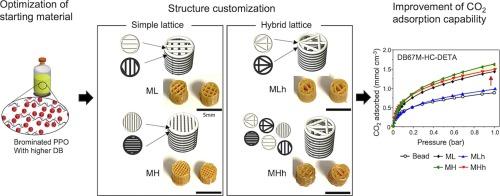利用优化的3d打印结构吸附剂提高二氧化碳捕获效率
IF 9
1区 工程技术
Q1 ENGINEERING, CHEMICAL
引用次数: 0
摘要
3d打印的二氧化碳吸附剂在工业应用中具有重要的前景,但面临着诸如粘合剂使用导致效率降低和可扩展性限制等挑战。这项研究建立在我们之前开发的无粘合剂3D打印平台上,使用溴化聚(2,6-二甲基-1,4-苯基氧化物)(Br-PPO)。利用其低粘度液体油墨的高印刷性、印后灵活性、高气体选择性和稳定性等优势,在本研究中,我们的目标是提高二氧化碳捕获性能,同时保持与印后工艺的兼容性。我们的方法采用了三个关键策略:(1)提高PPO的溴化水平,以提高固有的二氧化碳吸附能力;(2)优化3D吸附剂结构,在不影响打印后工艺的情况下提高表面体积比和包装密度;(3)模块化3D打印吸附剂构建块,以解决可扩展性挑战。将PPO溴化提高到67 %,由于在印刷后的胺接枝过程中引入了更高的取代胺密度,CO2吸附能力提高了40 %。通过定制网格设计进行的结构优化表明,尽管孔隙率更高,但具有不均匀间距细丝(MHh)的吸附剂与均匀间距设计(MH)的吸附剂具有相当的二氧化碳捕获效率,强调了结构优化在提高吸附效率同时最小化质量方面的作用。3d打印吸附剂组件的动态流动测试进一步验证了平台的有效性,证明了在低流速(3 mm/min)下有效捕获二氧化碳,无压降,与同等体积下的活性炭相比,性能优越。这些发现突出了3d打印吸附剂的潜力,它们具有定制的几何形状,是二氧化碳捕获的可扩展解决方案,特别是在紧凑、节能的应用中,如先进的空气净化系统和工业气体分离过程。本文章由计算机程序翻译,如有差异,请以英文原文为准。


Enhancing CO2 capture efficiency using optimized 3D-Printed structured adsorbents
3D-printed CO2 adsorbents hold significant promise for industrial applications but face challenges such as reduced efficiency due to binder use and limitations in scalability. This study builds on our previously developed binder-free 3D printing platform using brominated poly(2,6-dimethyl-1,4-phenylene oxide) (Br-PPO). Leveraging its advantages of high printability with low-viscosity liquid ink, post-printing flexibility, and high gas selectivity and stability, in this study, we aim to improve CO2 capture performance while maintaining compatibility with post-printing processes. Our approach employs three key strategies: (1) increasing the bromination level of PPO to improve intrinsic CO2 adsorption capabilities, (2) optimizing 3D adsorbent structures to enhance surface-to-volume ratios and packing density without disrupting post-printing processes, and (3) modularizing 3D-printed adsorbent building blocks to address scalability challenges. Increasing PPO bromination to 67 % improved CO2 adsorption capacity by 40 %, driven by the higher density of substituted amines introduced during post-printing amine-grafting. Structural optimization through customized mesh designs demonstrated that adsorbents with unevenly spaced filaments (MHh) achieved comparable CO2 capture efficiency to evenly spaced designs (MH), despite higher porosity, underscoring the role of structural optimization in enhancing adsorption efficiency while minimizing mass. Dynamic flow tests with 3D-printed adsorbent assemblies further validated the platform’s effectiveness, demonstrating efficient CO2 capture at low flow rates (3 mm/min) without pressure drops and superior performance compared to activated carbon at equivalent volumes. These findings highlight the potential of 3D-printed adsorbents with tailored geometries as scalable solutions for CO2 capture, particularly in compact, energy-efficient applications such as advanced air purification systems and industrial gas separation processes.
求助全文
通过发布文献求助,成功后即可免费获取论文全文。
去求助
来源期刊

Separation and Purification Technology
工程技术-工程:化工
CiteScore
14.00
自引率
12.80%
发文量
2347
审稿时长
43 days
期刊介绍:
Separation and Purification Technology is a premier journal committed to sharing innovative methods for separation and purification in chemical and environmental engineering, encompassing both homogeneous solutions and heterogeneous mixtures. Our scope includes the separation and/or purification of liquids, vapors, and gases, as well as carbon capture and separation techniques. However, it's important to note that methods solely intended for analytical purposes are not within the scope of the journal. Additionally, disciplines such as soil science, polymer science, and metallurgy fall outside the purview of Separation and Purification Technology. Join us in advancing the field of separation and purification methods for sustainable solutions in chemical and environmental engineering.
 求助内容:
求助内容: 应助结果提醒方式:
应助结果提醒方式:


